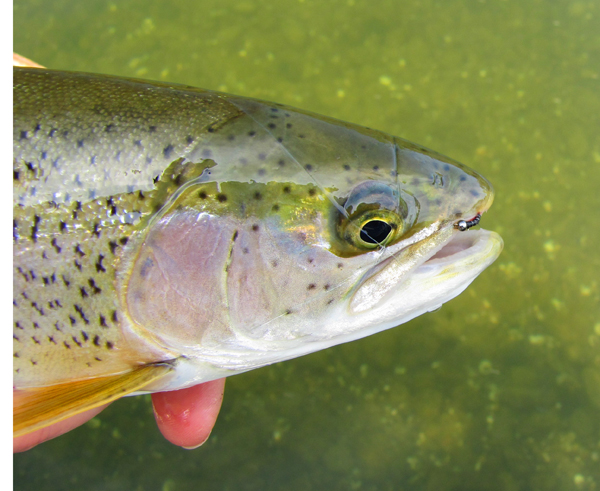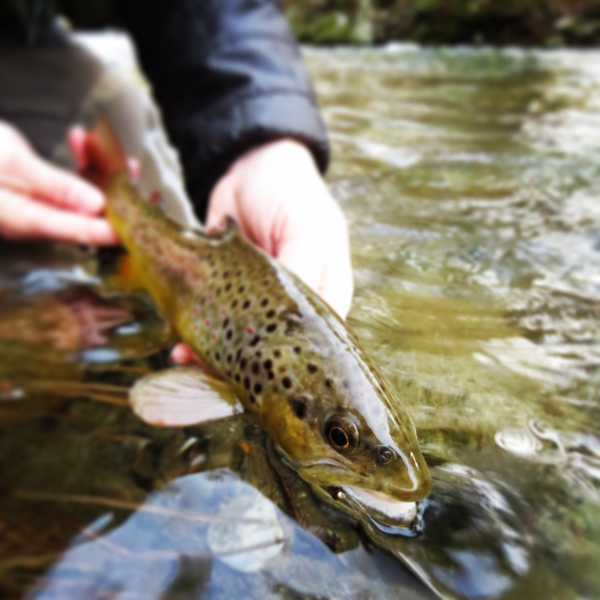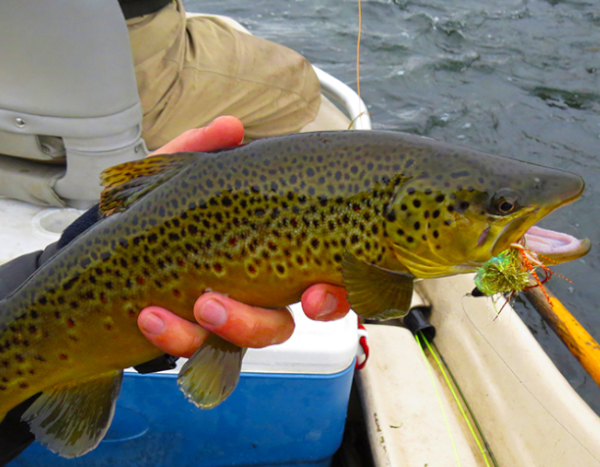One of the most common questions we’ll hear when we have anglers on the water is “Did you just pinch the barb on the hook?” We’re always a little bit startled because most of the time there’s a bit of an accusing tone as if we don’t want them to actually catch a fish, but nothing could be further from the truth.
Fishing with barbless hooks seems to have an aura about it where the perception is of a fly fisher who cares very little about catching a fish and generally expects every fish to come loose before being landed. We fish exclusively with either barbless hooks or hooks that we have crushed the barb and there are several good reasons.
The first reason we prefer barbless hooks is because we’re constantly in proximity to flies zipping through the air. You can only imagine how likely it is to eventually have a hook find us. We’re actually accustomed to the idea and are paying attention, watching for it. It’s more common for a second angler to get hooked since they’re usually paying more attention to a pretty scene around them or an osprey flying overhead. Hooks come out of your shirt or jacket far easier if they don’t have a barb. You can only imagine how much easier it comes out of your arm or, God forbid, your face if there’s not a barb.
When it comes to hooking fish, things aren’t nearly so obvious as you’d think. The general perception is that a barbed hook is superior to barbless when it comes to hooking fish and keeping them on. Something we often have to explain to some anglers is the process by which fish are hooked. Occasionally someone will miss several fish in a row and complain that the barbless hook is preventing them from getting a good hook up. The truth of the matter is that the trout usually spits the fly before the angler came tight to set the hook. A fish is not hooked just because it takes the fly in its mouth.
I’ll often illustrate this concept by holding the fly, checking it thoroughly, handing it to the angler and ask them to check if the hook point is sharp. After that I might even put the fly in my mouth, then spit it out. The fly was clearly in their hand and even in my mouth, but neither of us was hooked. It’s the hook set that hooks a fish, not the hook alone.
Barbless hooks can easily blamed for hooked fish coming off, but some experiments and observances lead me to question this. Many years ago I would intentionally fish all day long with barbed hooks. I kept track of how many trout came off and how many were landed. I did the same thing on another day with barbless hooks. This was something I did all season long in the Smokies and on our large tailwater rivers. The surprising result was that the percentage of trout that came off was very similar.
My experience in fishing saltwater leads us to believe that barbed hooks probably don’t hook up quite so well as barbless hooks. Every saltwater fly fishing guide we’ve ever been with insists on barbless hooks because they penetrate better than those with barbs. A tarpon’s mouth is exceptionally hard and a clean, barbless hook penetrates better than one with a barb that often stops short.
The various parts of a fish’s mouth are softer or tougher and any hook will have deeper or shallower penetration depending upon where it sticks. If your hook finds the corner of a fish’s jaw there is very little chance it will come out without your hemostats to pull it out. If your hook completely hooks soft tissue in the roof of a trout’s mouth, the hook can tear out if you play the fish too hard. In this instance there’s no difference between a barbless or barbed hook. Both hooked the fish but the hook pulled out.
For several years I took one particular fly fisher on numerous floats to target large trout with streamers. He was an extremely skilled fly tyer and always brought boxes full of gorgeous streamers. Because the flies are extra long and the fish were large as well he preferred articulated flies tied with two hooks. This style of fishing is low on the quantity of fish hooked but extra high when it comes to quality. This particular angler rarely hooked anything less than 16″ and landed fish up to 26″ with me, but only rarely put more than a very few fish in the net on any day. Because of the few fish hooked and the exceptionally large size it was particularly heart breaking whenever a fish came off.
Over the years this fly fisher went from fishing single hook streamers to articulated, double hook streamers. After a while he even went to adding a small treble hook to the head of on particularly large streamer pattern since so many fish grabbed the fly at the head, perhaps causing fewer good hook ups than when the fish took the fly closer to one of the hooks. I used to laugh and tell him that fly had more hooks than Bill Dance’s tackle box!
This was something of particular interest to me since this was a rather extreme fly, but one I got to observe on several occasions. What surprised me more than anything is that fish came unhooked from this fly just as frequently as anything else. And trust me… As the guy who reached into the net to pick up a thrashing fish with hooks going in every direction, those hooks were plenty sharp and the barbs were NOT crimped.
In the end I always recommend barbless hooks, but never get upset with folks who prefer barbs. In our experience barbless hooks are easier on both fish and anglers. In our experience barbed hooks don’t seem to land any more fish, just more snags in our shirts and jackets.



Jim Brady says
I have used barbless hooks since 1977. Over that time, I’ve concluded that fish lost during a fight are due to my not setting the hook firmly enough on the hookset. I once demonstrated to a friend that barbless hooks don’t come out if properly set by hooking a nice rainbow, setting the rod down and then picking the rod up again after five minutes ticked off my watch. The fish turned out to be a nice 15 incher.
I have even observed a hook having penetrated all the way up the bend until the end of the body stopped further penetration.
The hook must be properly sharpened to penetrate well. I use the Vince Marinaro test to check for sharpness. I carry a soft stone (used to sharpen small cutting tools) and take several stokes toward the hook point to the left and right of the point. Then I hold the hook point down against my thumb nail and drag the hook across the nail. The point should be sharp enough to be “sticky” and hang up on the nail surface. If it slides off, it’s not sharp enough.
Ian says
Jim,
You’ve got it right. I like to point out to skeptics that fish don’t have hands so it’s very hard for them to remove a hook on their own! And sharp hooks are always best.
Anthony Hipps says
Ian and Charity, I demand barbless or crimped barb hooks from friends fishing the New River in my canoe or fishing a lake in a motor boat. However, it has little to do with being able to release a healthy fish easily, though I am certainly concerned about that. It has everything to do with the fact I fish in a lot of remote places several miles (sometimes even a couple of hours), from the closest emergency care facility. In my younger life I have made 4 emergency runs to hospitals or emergency care units to get barbed hooks removed from myself or a friend. It is a real bummer to have to cut short a fishing trip to get barbed hooks removed. But, is is more of a bummer to go through an extended period waiting in discomfort and endure the price hit for medical hook removal. A friend of mine fishing on his own had to wait over two hours before the doctors could see him and extract the barbed hook embedded in his left cheek. His out of pocket expense was $350.00 for hook extraction, tetanus shot and antibiotic treatment. Better safe than sorry. On another note, I have lost very few fish because of using a barbless hook. God Bless and tight Lines, Anthony Hipps
Ian says
Yes, Anthony, you’ve pretty well hit it on the head. As guides we’re always concerned with safety so going barbless is the best way to go.